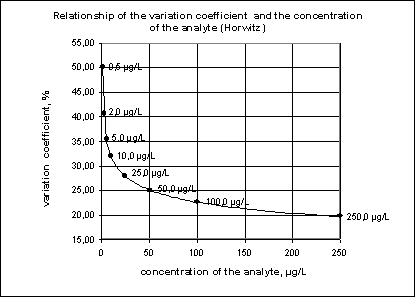Precision Criteria
The major aim of an external quality assessment scheme is to examine the comparability of the results from different laboratories for an Analytes. According to Horwitz [1], who found, that the variation coefficient could be expressed as a function of the concentration according to the following equation by using data based on 150 independent surveys.
VC = 2(1-0.5 log C)
VC = variation coefficient (%)
C = concentration of the analytes (kg/L !)
The surveys were implemented with different Analytess, different concentration ranges and five different methods for analysis: chromatography, AAS, spectrometry, polarography, bioassay. A consequence of the function is that the variation coefficient is halved when the concentration is increased by factor 100. The following diagram shows the summary of all accessible results of interlaboratory testing schemes up to 1982. This Horwitz function is independent of the analytes, the applied method and the conditions of the samples. The variation coefficient calculated from this function can be an indicator for the efficiency in the method regarding interlaboratory comparison. Horwitz’s equation is based on results which are already 17 years old. Since 1982 technical progress have increased the performance of the analytical methods. However the precision of any analytical method is only one aspect among others such as handling and processing of the samples. All surveys showed that Horwitz’s equation can be used to assess the efficiency of analytical methods (conditions depending on the ring test). In our quantitative ring tests we have proven that the standard deviation according to Horwitz is suitable for the evaluation of participant results.

A further possibility of evaluating the results of interlaboratory tests is the evaluation according to the ISO 5725 [2]. The comparison standard deviation which can be calculated according to ISO 5725 depends only on the efficiency of the participants of the survey. This means in case of more strongly strewing data pools the borders for the assessment of the results are extented in the comparison to the Horwitz procedure [3]. However the calculation of the evaluation borders requires multiple determination (at least two independent measured values) of the analytes according to ISO.
Literature:
[1] HORWITZ, W (1982)
Evaluation of analytical methods used for regulation of foods and drugs.
Anal. Chem. 54 (1): 67A -76A
[2] DIN ISO 5725 (1994)
International Organization for Standardization. Genauigkeit (Richtigkeit und Präzision) von Messverfahren und Messergebnissen. ISO Central Secretariat, 1, rue de Varamba, CH 1211 Genf 20, Schweiz
[3] Herbold M, Schmitt G, Aderjan R (2003)
Auswertung forensischer Ringversuche nach ISO 5725, Beispiel: Haare - Ringversuche 2002. In: Symposium der GTFCh, Mosbach/Baden, Hrsg.: F. Pragst, R. Aderjan, Dr. Dieter Helm Verlag, Heppenheim
